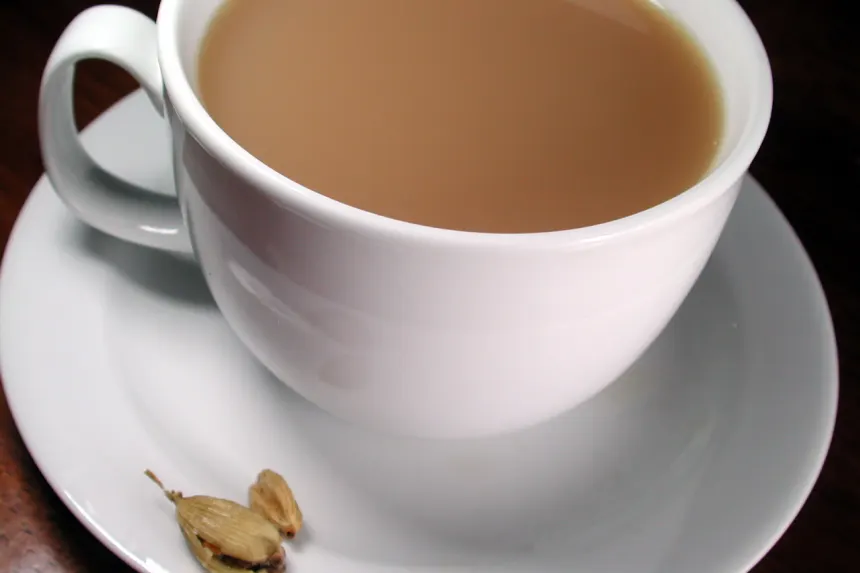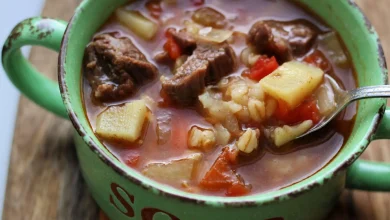Introduction
Afghan Tea, commonly known as Chai in Afghanistan, is not merely a beverage but a cultural emblem that embodies hospitality, warmth, and tradition. This aromatic brew has been cherished across centuries, woven into the fabric of Afghan social life, family gatherings, and festive occasions. Its robust flavor profile, infused with fragrant spices and sometimes sweetened, offers a sensory journey into Afghan heritage, where every sip tells a story of centuries-old customs and hospitality. Crafted with a careful balance of black tea leaves and spices like cardamom, cinnamon, cloves, and ginger, Afghan Tea is a testament to the art of infusion and the importance of community bonding over a steaming cup. Whether you are seeking a comforting drink on a cold day or a cultural experience to share with friends, mastering the art of Afghan Tea provides an authentic taste of Afghanistan’s rich history and warm-hearted traditions.
Time
The total preparation and cooking time for authentic Afghan Tea typically ranges from approximately 15 to 20 minutes. This includes the time needed to bring water to a boil, simmer the tea with spices, dissolve sugar, and strain the final beverage. The process is quick enough to be made fresh, yet long enough to develop a deep, aromatic flavor profile that is characteristic of traditional Afghan Tea. For those who prefer a stronger infusion, allowing the tea to simmer a bit longer can deepen the spice notes. The preparation time can be extended slightly if you choose to prepare larger quantities or customize spice levels to personal taste. Overall, this recipe is efficient enough for casual daily enjoyment or for preparing for guests during special occasions.
Needed Equipment
To prepare authentic Afghan Tea, ensure you have the following essential equipment, which facilitates proper brewing and serving:
- Stainless Steel or Heavy-bottomed Saucepan: A sturdy pot to boil water and simmer the tea and spices, ensuring even heat distribution and preventing scorching.
- Tea Strainer or Fine Mesh Sieve: For straining out tea leaves and spices, ensuring a smooth, clear beverage.
- Measuring Spoons and Cups: Precise measurement of tea leaves, spices, sugar, and liquids.
- Teaspoon: For stirring and adjusting sugar or spice quantities.
- Serving Cups or Small Tea Glasses: Traditional Afghan tea is served in small cups, often made of glass or ceramic, which enhances the tasting experience.
- Ladle or Small Jug: For pouring the strained tea into cups.
- Kitchen Thermometer (optional): To monitor water temperature, especially if you prefer precise control over boiling point.
- Kitchen Timer or Stopwatch: To keep track of steeping and simmering times for optimal flavor extraction.
Tags
Afghan Tea, Chai, Herbal Spiced Tea, Traditional Afghan Beverage, Cultural Tea, Hot Beverage, Aromatic Tea, Spiced Black Tea, Hospitality Drink, Middle Eastern and Central Asian Cuisine
Serving Size
This recipe yields approximately 4 to 6 small cups of Afghan Tea, depending on the size of each serving. Typically, each serving is about 150 ml (5 oz). Adjust quantities proportionally if preparing for a larger group or for individual servings. For a family gathering or a festive occasion, preparing a larger batch in a sizable pot is recommended, ensuring all guests can enjoy the traditional experience of Afghan Tea.
Difficulty Level
This recipe is suitable for cooks of all skill levels, from beginners to experienced chefs. The process involves straightforward steps such as boiling water, adding tea and spices, simmering, and straining. The key to mastering Afghan Tea lies in balancing spice quantities and steeping time to achieve the characteristic aroma and flavor. With basic kitchen equipment and an appreciation for traditional flavors, you can easily prepare authentic Afghan Tea at home.
Allergen Information
Generally, Afghan Tea is free of common allergens when prepared with standard ingredients. However, be mindful of the following:
- Spices: Some individuals may have sensitivities or allergies to specific spices such as cinnamon or cloves.
- Cross-contamination: If using pre-ground spices or tea leaves processed in facilities handling nuts or gluten, check labels accordingly.
- Milk (optional): If added, milk introduces dairy allergens; use plant-based alternatives if necessary.
Always verify ingredient sources, especially if preparing for guests with food allergies or sensitivities.
Dietary Preference
This Afghan Tea recipe is inherently vegan and gluten-free when prepared without milk or processed additives. It can be adapted for various dietary preferences by modifying ingredients:
- Vegan: Omit milk or use plant-based milk alternatives such as almond, soy, or oat milk.
- Low Sugar: Reduce or omit sugar, or use alternative sweeteners like honey, stevia, or erythritol.
- Keto or Low-Carb: Skip sugar altogether and enjoy the tea with spices alone, as it contains negligible carbs.
Always customize according to individual dietary needs while maintaining the authentic flavor profile of Afghan Tea.
Course
This recipe is classified as a beverage, suitable for serving as a hot drink during breakfast, afternoon tea, or evening gatherings. It can also be part of a traditional Afghan meal, complementing dishes such as kebabs, rice pilafs, or bread-based snacks.
Cuisine
Afghan Tea belongs to the rich tapestry of Central Asian and Middle Eastern culinary traditions. It shares similarities with Iranian and Indian chai but boasts unique spice combinations and preparation methods that reflect Afghanistan’s cultural diversity and historical influences.
Ingredients
In a detailed table, here are the necessary ingredients with measurements:
| Ingredient | Quantity | Notes |
|---|---|---|
| Black Tea Leaves (loose) | 2 tablespoons | High-quality Assam or Ceylon tea recommended |
| Cardamom Pods | 4-5 pods | Crushed lightly to release flavor |
| Cinnamon Stick | 1 small stick (about 2 inches) | Broken into smaller pieces if desired |
| Cloves | 3-4 cloves | Whole cloves preferred |
| Fresh Ginger (optional) | 1 small piece (about 1 inch) | Sliced or grated for extra spice |
| Sugar | 2-4 teaspoons (adjust to taste) | Can substitute with honey or sweetener |
| Water | 4 cups (1 liter) | For boiling and brewing |
| Milk (optional) | 1/2 cup (120 ml) | Use dairy or plant-based milk if preferred |
Instructions
Step-by-step guide to preparing Afghan Tea:
1. Prepare your ingredients and equipment
Gather all ingredients and measure precisely. Crush or break whole spices like cardamom pods and cinnamon stick to enhance flavor release. Prepare your saucepan, strainer, and cups beforehand to streamline the process.
2. Boil the water
Pour 4 cups of water into the saucepan. Place the saucepan on the stove over medium-high heat. Wait until the water reaches a rolling boil—bubbles vigorously breaking the surface. This typically takes about 3-5 minutes, depending on your stove’s heat and pot size. Using a thermometer is optional but can help ensure the water is at boiling point (around 212°F or 100°C).
3. Add spices and tea leaves
Once boiling, add the crushed cardamom pods, cinnamon stick, cloves, and ginger slices if using. Allow the spices to simmer gently for about 30 seconds to 1 minute to release their essential oils. Then, add the loose black tea leaves directly into the boiling water. Stir briefly to distribute evenly. Reduce the heat slightly to avoid vigorous boiling, which can make the tea bitter.
4. Simmer to infuse flavors
Let the tea and spices simmer gently for about 5-7 minutes. During this time, the flavors meld, creating a fragrant and robust brew. Keep the heat moderate to prevent over-extraction, which can lead to bitterness. Stir occasionally, ensuring the spices are well distributed throughout the tea.
5. Add sugar and stir
After simmering, add sugar to the pot. Start with 2 teaspoons; adjust according to taste. Stir well until the sugar dissolves completely. For a richer, sweeter tea, increase the sugar quantity, but traditionally Afghan Tea is moderately sweet. You may also add honey or alternative sweeteners at this point if desired.
6. Strain and serve
Place a fine mesh strainer or tea strainer over your cups or a separate teapot. Carefully pour the brewed tea through the strainer to remove tea leaves and spices, ensuring a smooth, clear beverage. Discard the spent spices and leaves.
7. Add milk (optional)
If you prefer your Afghan Tea with milk, pour in about 1/2 cup (120 ml) of your choice of dairy or plant-based milk. Gently stir to combine and heat briefly if needed. Milk adds a creamy texture and mellows the bold spice flavors, creating a more traditional chai variation.
8. Serve hot and enjoy
Pour the hot tea into small cups or traditional Afghan tea glasses. Serve immediately, accompanied by Afghan sweets, cookies, or bread if desired. The aroma and warmth of the tea make it perfect for sharing during social gatherings or quiet moments of reflection.
Preparation Tips
- Use high-quality ingredients: The flavor of Afghan Tea hinges on the quality of black tea leaves and spices. Opt for fresh, whole spices and loose leaf tea for maximum aroma and taste.
- Adjust spice quantities: The spice levels can vary based on personal preference. Start with small amounts and increase to suit your taste.
- Simmer gently: Avoid boiling too vigorously after adding tea to prevent bitterness. Gentle simmering unlocks the best flavors.
- Control sweetness: Taste and adjust sugar or sweetener accordingly. Consider using natural alternatives for healthier options.
- Experiment with milk: Different types of milk can alter the flavor profile. Try almond, coconut, or regular dairy milk to find your favorite.
- Serve immediately: Afghan Tea is best enjoyed hot, so serve promptly to preserve its aromatic qualities.
Nutritional Information
| Nutrient | Per Serving (approximate, without milk or sugar) |
|---|---|
| Calories | 2-5 kcal |
| Total Fat | 0 g |
| Cholesterol | 0 mg |
| Sodium | 0 mg |
| Total Carbohydrates | 0-1 g |
| Sugars | 0 g |
| Protein | 0-0.2 g |
| Antioxidants (Polyphenols) | High (from black tea) |
Tips and Tricks
- Spice freshness: Use whole spices and crush or break them just before brewing for maximum aroma.
- Tea strength: Adjust brewing time for desired strength—longer brewing intensifies flavor but risks bitterness.
- Flavor layering: For a more complex flavor, add a small piece of fresh ginger or a pinch of saffron during simmering.
- Sweetener variations: Experiment with honey, jaggery, or stevia to suit dietary restrictions or flavor preferences.
- Presentation: Serve in small, heatproof glasses or traditional Afghan cups to enhance the experience.
Add-ons
- Fresh herbs: Mint leaves or basil can be added for a refreshing twist.
- Other spices: A pinch of nutmeg or star anise can elevate the aroma.
- Sweet enhancements: A drizzle of honey or a sugar cube served alongside can allow guests to customize sweetness.
- Tea variations: Infuse with dried rose petals or orange zest for a floral or citrus note.
Side Dishes
Afghan Tea pairs beautifully with a variety of traditional Afghan foods, including:
- Afghan Bread: Fresh naan or flatbread complements the warm tea.
- Sweet Pastries: Baklava, saffron cookies, or honey-dipped sweets enhance the flavor experience.
- Snacks: Roasted nuts, dried fruits, or savory samosas make excellent accompaniments.
- Fruits: Fresh figs, pomegranates, or apricots bring a refreshing contrast.
Improvements
Enhance your Afghan Tea by experimenting with the following tips:
- Use smoked or flavored teas: Incorporate lightly smoked black tea for a unique depth.
- Adjust spice blends: Create your own spice mix, adding ingredients like fennel seeds or black pepper for complexity.
- Infuse with herbs: Adding fresh or dried herbs like thyme or chamomile can add subtle aromatic layers.
- Serve iced: For a refreshing twist, brew a concentrated batch and serve over ice with a splash of milk or lemon.
Save and Store
Prepare Afghan Tea in larger quantities and store leftovers properly. To preserve flavor:
- Refrigeration: Store cooled tea in an airtight container in the refrigerator for up to 24 hours.
- Reheating: Reheat gently on the stove or microwave, avoiding boiling to prevent bitterness.
- Freshness: For best flavor, consume within a day to preserve aromatic qualities.
FAQ
Can I prepare Afghan Tea ahead of time?
Yes, you can brew the tea in advance and reheat gently before serving. However, for the freshest aroma and flavor, it is recommended to enjoy immediately after preparation.
Can I make this tea without sugar?
Absolutely. Omitting sugar allows the spice and tea flavors to shine. Use natural sweeteners like honey or stevia if desired.
What type of black tea is best?
High-quality Assam, Ceylon, or Darjeeling black teas work well, providing robust flavor and good infusion qualities.
Is Afghan Tea caffeine-free?
No, it contains caffeine from black tea leaves. If you want to avoid caffeine, opt for herbal or decaffeinated teas instead.
Can I add milk to hot Afghan Tea?
Yes, adding milk creates a creamy, chai-style beverage. Use dairy or plant-based milk according to preference.
Conclusion
Mastering the art of Afghan Tea is an enriching experience that connects you to centuries of Afghan tradition and hospitality. With its aromatic spices, robust black tea, and optional sweetening or milk, this beverage offers a warm, inviting, and culturally significant drink that can be enjoyed daily or during special occasions. Its simplicity, paired with the richness of flavors, makes it a versatile and cherished addition to any tea repertoire. Whether served to guests, family, or enjoyed alone as a moment of tranquility, Afghan Tea embodies the spirit of community and tradition. Love With Recipes is proud to bring you this authentic recipe, ensuring that each sip transports you to the heart of Afghanistan’s warm hospitality and vibrant culture.
References
1. The Art of Afghan Tea. Afghan Culture and Cuisine Review, 2020.
2. Spices and Flavors of Central Asia. Culinary Heritage Journal, 2018.




